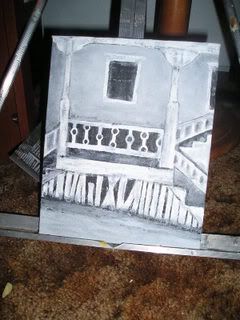Upon my initial encounter with the Davidian boys, I was thoroughly impressed by their energetic, glammed-up stage-show, and aggressive yet mature blistering punk sound that reminded me, at the time, more of “No Lunch”-era D Generation than anything else. From the start of their set to the end, they were tight, professional, and kept the crowd captivated.
Blanche Davidian still impresses me with these same traits, but on their new record, “Orange Sunshine,” they also demonstrate that they have elevated their craft to a level that far transcends being merely an independent band that happens to be more interesting to watch than most.

Listening to “Orange Sunshine,” I now hear hints in the Davidians of the raw power-pop stylings of “Live at Budakon,” “Radar Love”/ “Barroom Blitz”-style anthemic campiness, a bit of “Night at the Opera” vocal harmonizing, the occasional vocal-part reminiscent of an early Michael Stipe, and a touch of cherry and oak in the slightly tannic finish.
Singer Jamie Monistat VII’s lyrics are gritty, creative and steeped with perverse wit, in a way that reminds me a bit of a more spastic William Burroughs when read on paper. One of the most noteworthy aspects of his writing-style is that the lyrics create a bit of a “Where’s Waldo” game of pastiche and intertextuality. Each song seems loaded with toungue-in-cheek references to other songs, borrowed and altered lyrics, and ironically placed fragments of familiar melody lines. This is particularly obvious on the song “Brimstone Jannie,” which strikes me as a verbal collage of borrowed elements decoupaged creatively and sarcastically (with gobs of glittery mud as the laquer) around a chorus, as well as appearing in a large number of other places on the album, such as in the album‘s opening track, “The Five Muscatels,” where layers of non-lyrical vocal parts morph at one point into a familiar doo-woppy part lifted, to admirably surprising comic effect, from a Monkees song (I think? Maybe Billy Joel? The Grease soundtrack? You get the point, you’d recognize it…).
My biggest complaint upon initial listen to this record also turns out to be something that I respect immensely from an artistic and conceptual perspective. The tone and tempo of the record is, with a couple of exceptions, fairly uniform throughout, with only the melody-hooks of the vocals and the guitar solos (which are exceptionally written and played by Mike Hawk and Nikki Seven, with stylings that are more often than not [to my great pleasure] more thoroughly “power-metal” than “punk”) cutting through what is at other points a somewhat monotonous first-listen. In this regard, I find that some of the album’s artwork is exceptionally well-chosen. On the disc itself is printed an orange-and-black mesmerism spiral, which gives way to a photograph of an atom-bomb explosion on the tray when the disc is removed. In light of these visual symbols, the trance-like consistency of the album’s sound seems quite deliberate. Listening again with these visual representations in mind, the record seems to, overall, suggest several layers of psychedelic spirals, in feeling very similar to the orange spiral on the disc, giving way to “explosions,” which lead to drops or rises to lower or higher levels of the intensity of the spiral. Probably the most easily exemplified of these transitions is in the song “Hale-Bopp Panty Raid,” which features a drastic fall to the softest segment of the record (featuring still more of Mr. Monistat’s witty lyrical pastiche… “knock knock knockin’ on Heaven’s Gate”, etcetera), which proves just as (if not more) psychedelically spirally than the more intense moments of the record, such as the one that it builds and explodes back into. If it is a coincidence that the cover-song that follows this track (Warrior Soul's “Let’s Get Wasted”) contains a lyric that refers to an explosion, it’s an extremely accidentally apt and ironic one.
Overall, the effect created by these tonal spirals and explosions works well with other thematic elements of the lyrics and packaging of “Orange Sunshine.” Nuclear fallout, psychedelia, hypnosis, drugs, realism so gritty that it’s unbelievably hazy, cults… are all thematic elements that seem exceptionally well, yet exceptionally ambiguously and appropriately confusingly, treated by the thorough-going statement being made by the record as a whole. This is one of several recent records that makes me wonder if music could be the next viable medium for effective displays of authentic Surrealism. As all modern painting in the genre seems mere pale Dali imitations, and the conceptual intent of DaDa poetry has sunk far enough into the cultural understanding that the point it makes is no longer as pertinently discomforting, the sonic palette could very well be this genre’s next frontier. If this is the case, Blanche Davidian could very well be among our best current demonstrators of how it could be done, and their new record "Orange Sunshine" is a well-crafted step in the right direction.








